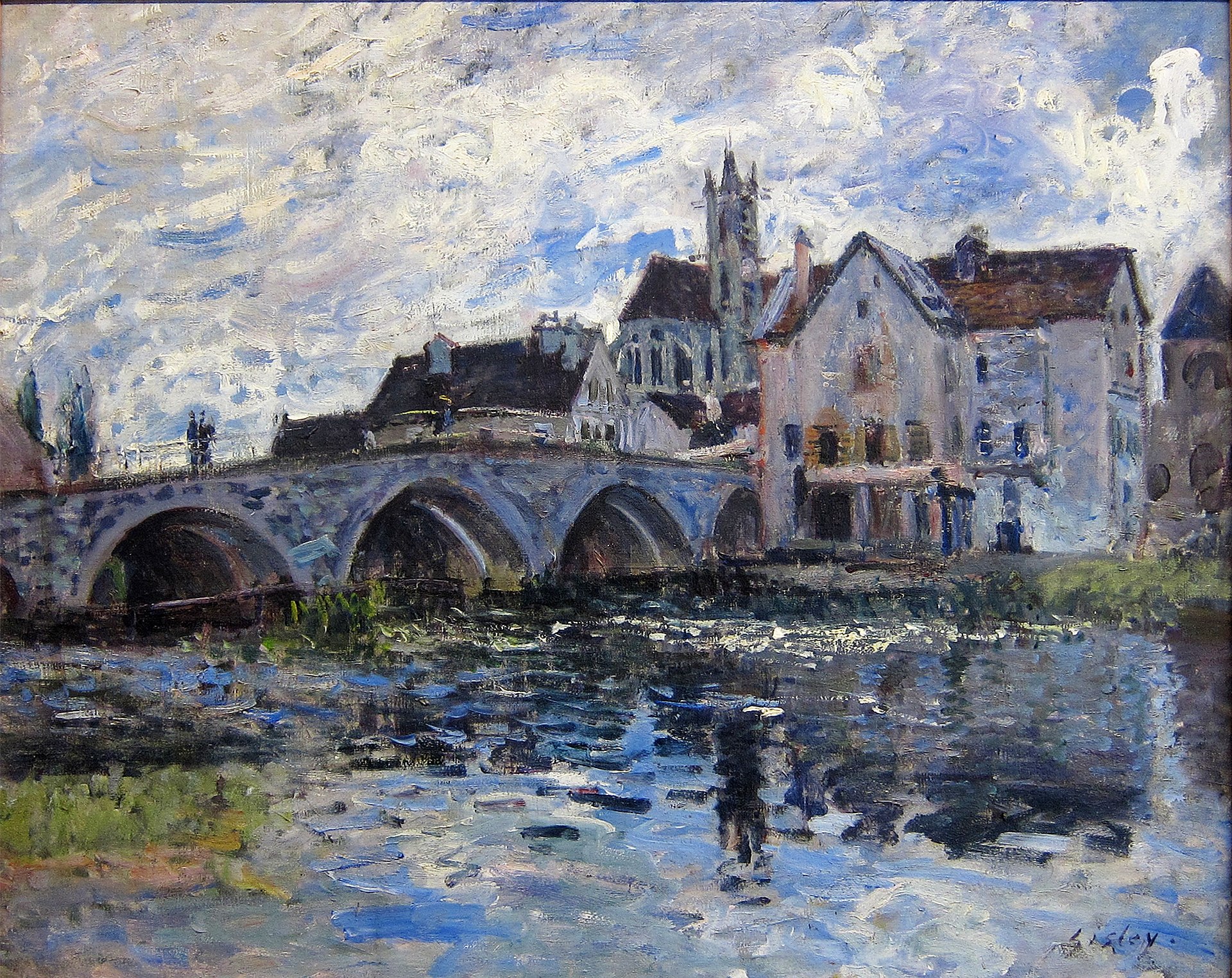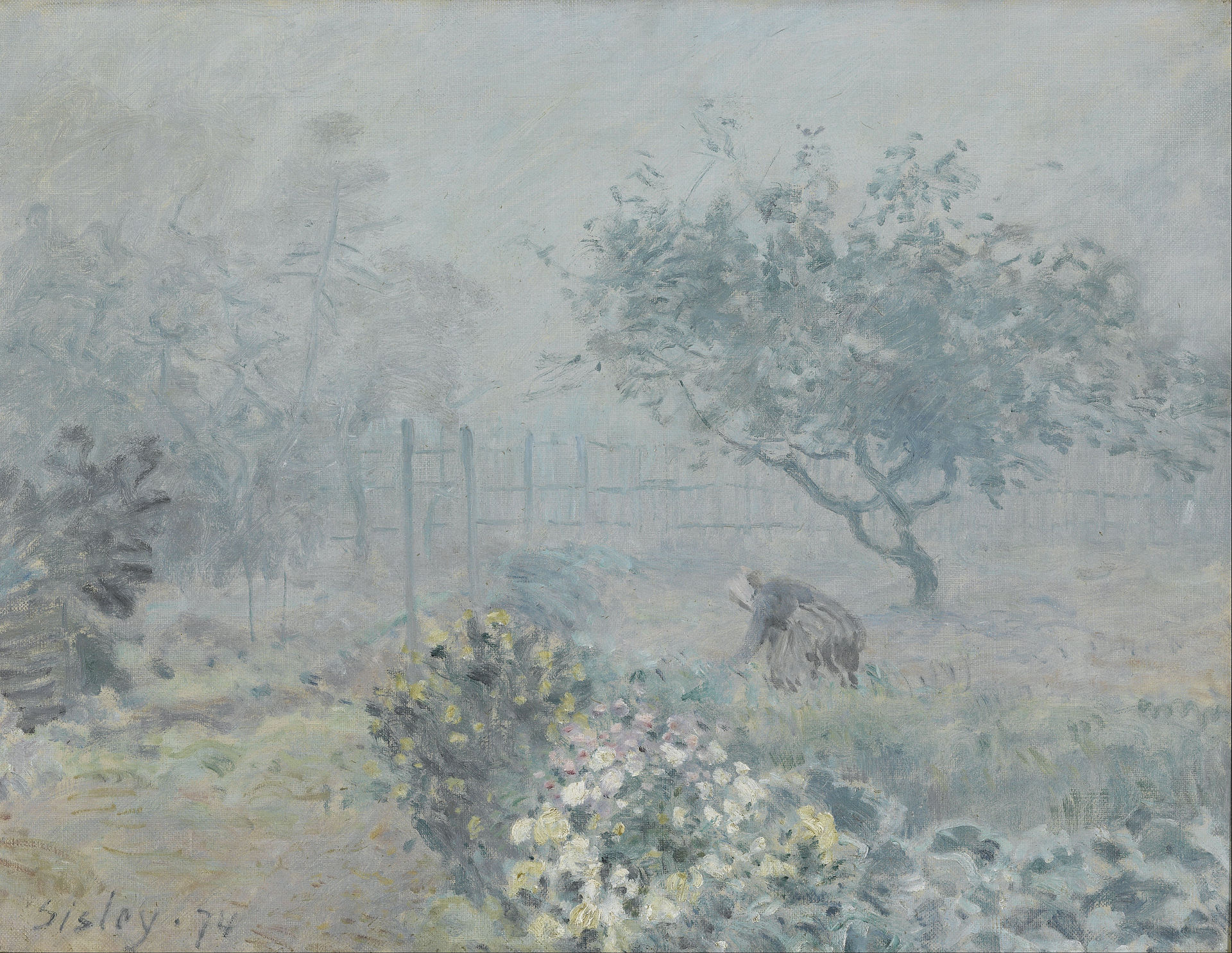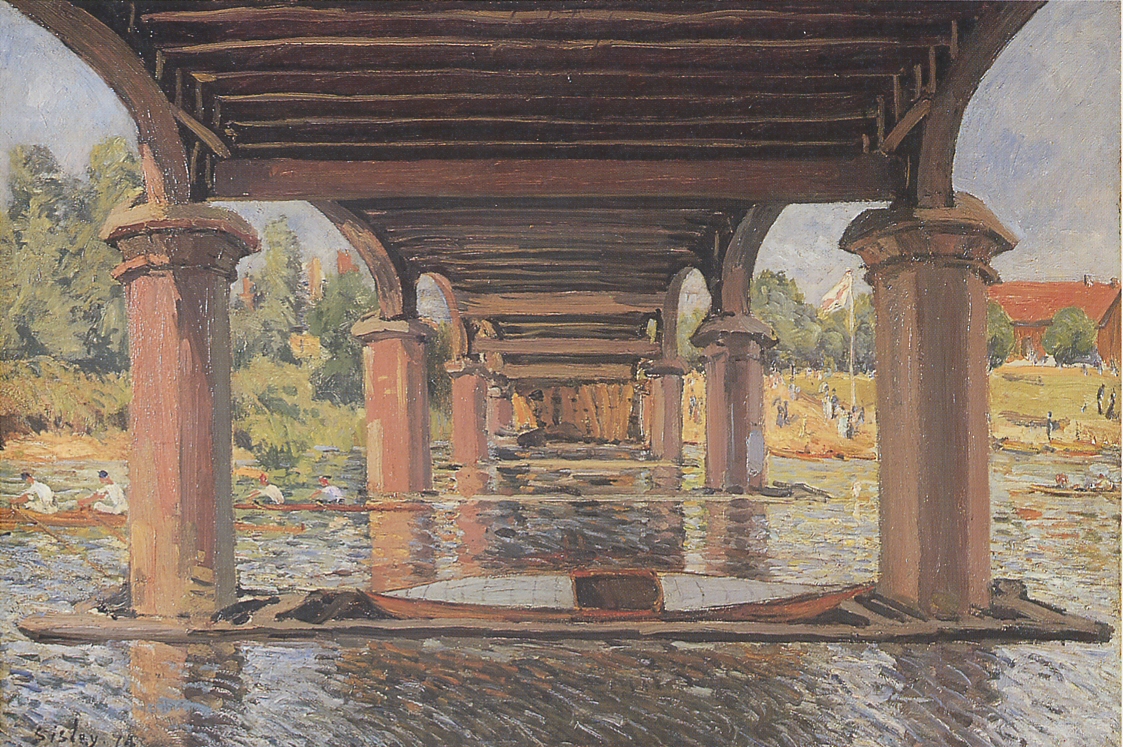18 Chapter 9 – Alfred Sisley
“Purest of All the Impressionists”
Lindsey Beamish
Audio recording of chapter is available here: https://drive.google.com/file/d/1N3jfOsutJFymJUNxUbgFUdZsFZ1sf7YI/view?usp=sharing

Alfred Sisley was an Impressionist painter in the nineteenth-century. He started his artistic journey when he joined Gleyre’s studio in Paris. During his time at the studio he met what would eventually be fellow Impressionist artists, Pierre-Auguste Renoir, and Claude Monet.[1] They worked alongside each other and created a revolutionary change in the world of art that would later be described as Impressionism. This did not come easy, there were many harsh critics at the beginning stages of Sisley’s career. Life as an artist has many challenges and unpredictability, and this was the case for Sisley. He faced many obstacles, in regards to his artwork which led to financial struggles throughout his life. For the most part, Sisley was labeled with the “status as a “minor” Impressionist”due to the lack of documentation and criticism of his work compared to his fellow Impressionist artists.[2] Sadly, Sisley died in 1899, at the age of fifty-nine. It was in the last decade of his life while living in Moret-sur-Loing, that Sisley “fully capitalized on its picturesque potential.” [3] He had previously painted landscapes at Moret but it was at this time he found his niche and painted what he is so well known for today. It was years after his death that he got the recognition that he deserved. Today, it is evident that Sisley is recognized as one of the greatest Impressionist artists of all time. When looking at his work we can clearly see his unique abilities in capturing the essence of his artistic visions.

In order to fully appreciate and respect Sisley’s impact in the art world, it is important to understand Impressionism. “Initially, it was not the artists themselves who described themselves as Impressionists…” It was a journalist, Louis Leroy that dubbed a group of independent artists as an “Exhibition of the Impressionists.”[4] “It was Claude Monet’s painting, Impression, Sunrise” that initiated the name.[5] After this, the artists themselves used this term to describe their art.[6] It is important to note that, “Impressionist artists were not trying to paint a reflection of real life, but an ‘impression’ of what the person, light, atmosphere, object or landscape looked like to them.

They tried to capture the movement and life of what they saw and show it to us as if it were happening before our eyes. … Impressionists painted outdoors…they looked at how light and colour changed the scenes.[7] To achieve the artist’s perspectives, specific painting techniques were used widely in the Impressionist genre, they are as follows:
They used short, thick strokes of paint to capture the essence of the object rather than the subject’s details. Quickly applied brush strokes give the painterly illusion of movement and spontaneity. A thick impasto application of paint means that even reflections on the water’s surface appear as substantial as any object in a scene. The Impressionists lightened their palettes to include pure, intense colours. Complementary colours were used for their vibrant contrasts and mutual enhancement when juxtaposed. Impressionists often painted at a time of day when there were long shadows. This technique of painting outdoors helped impressionists better depict the effects of light and emphasize the vibrancy of colours. They used Optical Mixing rather than mixing on the palette.[8]

“From around 1872 to 1876, Sisley…provides us with an A to Z of Impressionist effects within a comprehensive range of landscape motifs.” At this time his work captivated effects such as, “hoarfrost, mist, autumn fog, morning dew, high July clouds, threatening winter sky, and dark summer rain.”[9] “His longest and best known series is the Church of Moret, seen in all weathers.“[10] The series was broken into two “sub-groups” that were categorised by the side of the church he would focus on. The first group was the west facade of the church, he would primarily focus on the silhouettes that would change during the day according to the level of the sun, as well as working during a range of weather to showcase the church in all conditions.

The second group was the southern facade and transept, and the market hall, where he would focus on different angles and change his positioning. Similar to the first sub group he would also work in different weather conditions, specifically rainy or sunny midsummer days. Sisley himself claims this series to be his best work. Taken from a letter he wrote to Adolphe Tavernier, Sisley said, “It is in Moret, amid the dense nature, with its tall poplars and the beautiful, transparent, changing waters of the Loing…that my art has undoubtedly developed most; especially in the last three years…I will never really leave this little place that is so picturesque.”[11] Not only did Sisley capture the Church in Moret, he also had beautiful paintings of river banks, bridges, ports, and other buildings. He truly was able to produce breathtaking art throughout the commune of Moret-sur-Loing. Some of Sisleys most memorable pieces come from the beauty he found in Moret.

Sisley’s main inspiration and interests were, “unusual views of bridges, he depicted this imposing structure from water level, looking at it from underneath, as well as everyday detail of local streets, often painting views from his own home or from close by.”[12] He was also fascinated by engineering structures, the variety of road and rail bridges…and the impact of extreme weather conditions.[13] Sisley liked “remote or quiet, unvisited locations.”[14] This is also a reflection of his personality. Sisley was a very private man; he was “reluctant to speak about his work”.[15] The beauty in this is “the paintings must speak for themselves… due to the “lack of commentary on his work.”[16]

One document that was retrieved was a letter Sisley wrote to Adolphe Tavernier on January 24, 1892, he stated, “The sky must be the medium, the sky cannot be a mere backdrop. Not only does it give the picture depth through its successive planes, but through its form… it gives it movement. Is there anything more beautiful and more moving than the sky…What movement, what allure, don’t you agree?…I always begin by painting the sky.”[17] Reading these words really captures Sisley’s true passion for his work and is spine tingling to hear words that came directly from his mind. Since there is very little written work or even oral sources directly from Sisley, his letter to Tavernier has to fill in those gaps that researchers and historians try to dig up.
Art critic Octave Mirbeau describes Sisley: “His very delicate, lively sensibility was at ease before all the glories of nature… M.Sisley understood lovely light, the transparency of the envelope of air, the mobility and changeability of reflection, and the speed of movement.”[18] All these aspects define what it takes to be an artist in the Impressionist movement. Even though Sisley may not have had the recognition, and the success he deserved in his lifetime, he is now identified as one of the artists who created this genre.[19] “Alfred Sisley was perhaps one of the purest of all the Impressionists. He adhered throughout his career to the style of divided light and colour, momentary effects of illumination, and an acute responsiveness to atmosphere that are signature aspects of Impressionism.”[20]

Bibliography
Caves, Julie. “Impressionist Painting Techniques.” Jackson’s. Last modified April 24, 2015. Accessed October 21, 2021. https://www.jacksonsart.com/blog/2015/04/24/impressionist-painting-techniques/.
Chatelet, Albert. Impressionist Painting. New York: McGraw-Hill Book Company, 1962.
Haskins, Katherine. Art Documentation: Journal of the Art Libraries Society of North America 12, no. 1 (1993): 34–34. http://www.jstor.org/stable/27948524.
Sisley, Claude. “The Ancestry of Alfred Sisley.” The Burlington Magazine 91, no. 558 (1949): 248–52. http://www.jstor.org/stable/870068.
Skrpaits, Joseph C. “Mind Over Matter: Alfred Sisley’s Churches.” American Artist (1995). https://link.gale.com/apps/doc/A16679892/CPI?u=red68720&sid=bookmark-CPI&xid=b0d1d016.
Schaefer, Iris, Caroline von Sainte-George, and Katja Lewerentz. Painting Light: The Hidden Techniques of the Impressionists. Italy: Skira, 2008.
Stevens, Mary Anne, Isabelle Cahn, Caroline Durand-Ruel Godfroy, William R. Johnston, and Christopher Llyod. Alfred Sisley. London: Royal Academy of Arts, 1992.
Stevens, Mary A., Richard Shone, and Kathleen Adler. Alfred Sisley: Impressionist Master. Paris, France: Hazan, 2017.
The Impressionist Masters. Films On Demand. video, 26:57. 2011. Accessed September 21, 2021. https://fod.infobase.com/PortalPlaylists.aspx?wID=103278&xtid=50302.
[1] MaryAnne Stevens, Isabelle Cahn, Caroline Durand-Ruel Godfroy, William R. Johnston, and Christopher Llyod., Alfred Sisley. (London: Royal Academy of Arts, 1992), 259.
[2] Stevens, Alder, and Shone, Alfred Sisley Impressionist Master. Pg. 30
[3] Stevens, Alder, and Shone, Alfred Sisley Impressionist Master. Pg 162
[4] Iris Schaefer, Caroline von Saint- George, and Katja Lewerentz, Painting Light: The Hidden Techniques of the Impressionists. (Italy: Skira, 2008). pg .19
[5] Albert Chatelet, Impressionist Painting. (New York: McGraw-Hill Book Company, 1962). Pg.4.
[6] “Impressionism .” Tate Kids. https://www.tate.org.uk/kids/explore/what-is/impressionism.
[7] Julie Caves “Impressionist Painting Techniques.” Jackson’s. Last modified April 24, 2015. Accessed October 21, 2021. https://www.jacksonsart.com/blog/2015/04/24/impressionist-painting-techniques/.
[8] Stevens, Alder, and Shone, Alfred Sisley Impressionist Master.Pg.26
[9] Stevens, Alder, and Shone, Alfred Sisley Impressionist Master. Pg.28
[10] Stevens, Alder, and Shone, Alfred Sisley Impressionist Master. Pg,162
[11] Stevens, Alder, and Shone, Alfred Sisley Impressionist Master. Pg 65.
[12] Stevens, Alder, and Shone, Alfred Sisley Impressionist Master. Pg. 22
[13] Stevens, Alder, and Shone, Alfred Sisley Impressionist Master. Pg. 28.
[14] Stevens, Alder, and Shone, Alfred Sisley Impressionist Master. Pg. 154.
[15] Stevens, Alder, and Shone, Alfred Sisley Impressionist Master. Pg. 112.
[16] Albert Chatelet, Impressionist Painting. Pg.3.
[17] Stevens, Alder, and Shone, Alfred Sisley Impressionist Master.
- MaryAnne Stevens, Isabelle Cahn, Caroline Durand-Ruel Godfroy, William R. Johnston, and Christopher Llyod., Alfred Sisley. (London: Royal Academy of Arts, 1992), 259. ↵
- Stevens, Alder, and Shone, Alfred Sisley Impressionist Master. Pg. 30 ↵
- Stevens, Alder, and Shone, Alfred Sisley Impressionist Master. Pg. 162 ↵
- Iris Schaefer, Caroline von Saint- George, and Katja Lewerentz, Painting Light: The Hidden Techniques of the Impressionists. (Italy: Skira, 2008). pg .19 ↵
- Schaefer, Painting Light, 19 ↵
- Albert Chatelet, Impressionist Painting. (New York, McGraw-Hill Book Company. 1962). Pg.4. ↵
- "Impressionism ." Tate Kids. https://www.tate.org.uk/kids/explore/what-is/impressionism. ↵
- Julie Caves "Impressionist Painting Techniques." Jackson's. Last modified April 24, 2015. Accessed October 21, 2021. https://www.jacksonsart.com/blog/2015/04/24/impressionist-painting-techniques/. ↵
- Stevens, Alder, and Shone, Alfred Sisley Impressionist Master.Pg.26 ↵
- Stevens, Alder, and Shone, Alfred Sisley Impressionist Master.Pg.28 ↵
- Stevens, Alder, and Shone, Alfred Sisley Impressionist Master. Pg,162 ↵
- Stevens, Alder, and Shone, Alfred Sisley Impressionist Master. Pg 65 ↵
- Stevens, Alder, and Shone, Alfred Sisley Impressionist Master. Pg 65 ↵
- Stevens, Alder, and Shone, Alfred Sisley Impressionist Master. Pg. 22 ↵
- Stevens, Alder, and Shone, Alfred Sisley Impressionist Master. Pg. 28 ↵
- Stevens, Alder, and Shone, Alfred Sisley Impressionist Master. Pg. 28 ↵
- Stevens, Alder, and Shone, Alfred Sisley Impressionist Master. Pg. 154. ↵
- Stevens, Alder, and Shone, Alfred Sisley Impressionist Master. Pg. 112. ↵
- Albert Chatelet, Impressionist Painting. Pg.3. ↵
- Stevens, Alder, and Shone, Alfred Sisley Impressionist Master. ↵

